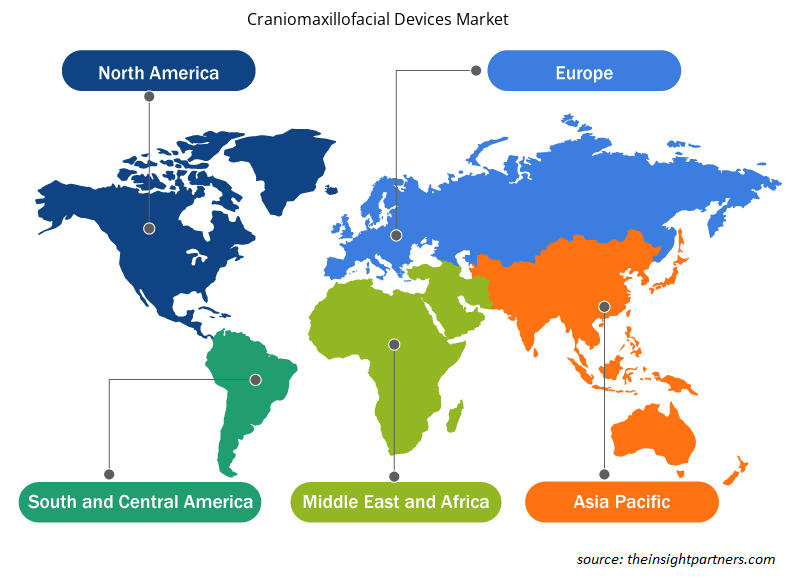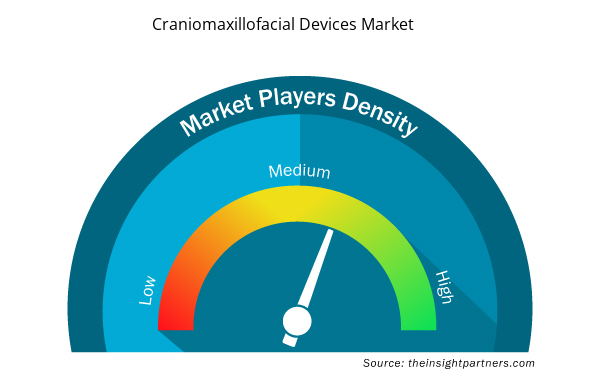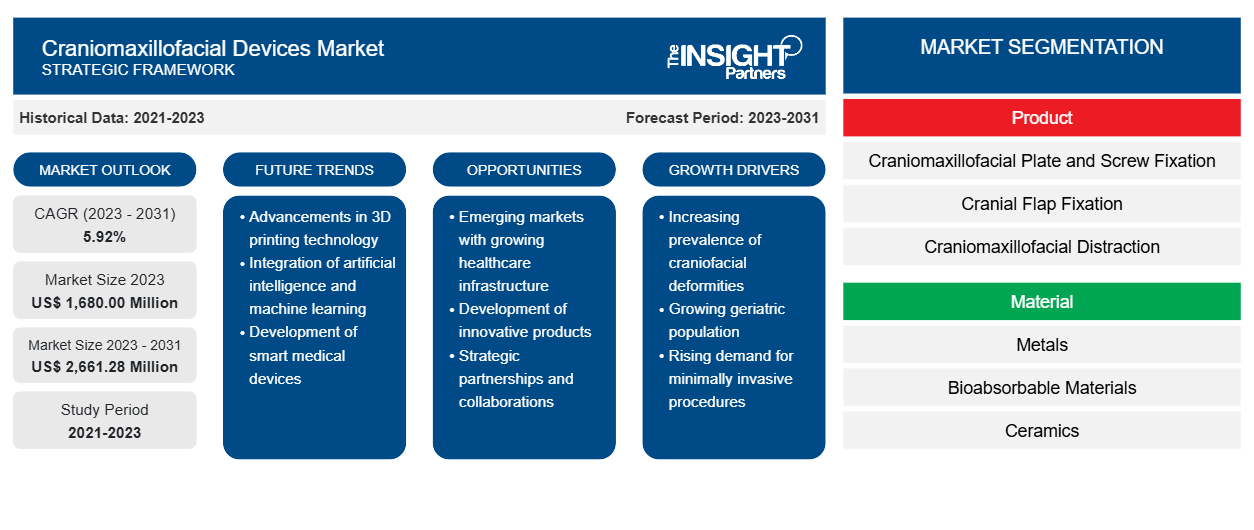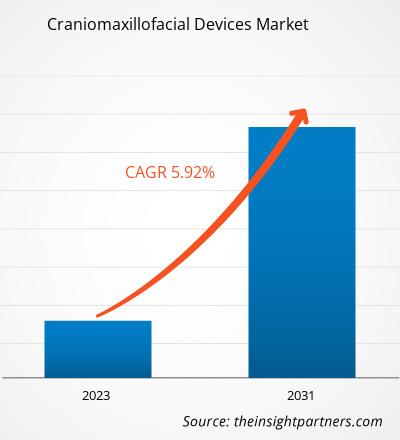[Rapport de recherche] La valeur du marché des dispositifs craniomaxillo-faciaux devrait passer de 1 680,00 millions USD en 2023 à 2 661,28 millions USD en 2031, à un TCAC de 5,92 % de 2023 à 2031.
Informations sur le marché et point de vue des analystes :
Les dispositifs craniomaxillofaciaux sont des équipements spécialisés, comprenant des instruments chirurgicaux, des plaques, des vis et des implants, conçus pour les procédures de traitement du visage, du crâne et de la mâchoire. Ces dispositifs sont essentiels pour traiter les maladies, les handicaps congénitaux, les blessures liées à un traumatisme, les déformations et les anomalies. Les dispositifs craniomaxillofaciaux sont fabriqués pour s'adapter aux structures anatomiques uniques du crâne et du visage. Ils sont conçus pour assurer la précision chirurgicale, redresser les traits du visage et aider à la guérison des os cassés. De plus, ces dispositifs aident à reconstruire les os du visage, à stabiliser les fractures et à améliorer les aspects fonctionnels et esthétiques des parties du corps affectées.
Les principaux facteurs à l’origine de la croissance du marché des dispositifs craniomaxillo-faciaux comprennent la demande croissante de procédures mini-invasives, les progrès des technologies d’impression et d’imagerie 3D et l’augmentation mondiale du nombre de blessures graves et de cas de fractures faciales. Les progrès des technologies d’impression et d’imagerie 3D permettent aux fabricants de proposer des solutions personnalisées aux clients. En plus des avancées technologiques et des solutions personnalisées, de meilleurs résultats pour les patients propulsent le marché des dispositifs craniomaxillo-faciaux. Les tendances du marché des dispositifs craniomaxillo-faciaux incluent les implants fabriqués à partir de matériaux biorésorbables pour minimiser les problèmes à long terme.
Moteurs de croissance et défis :
Le besoin de procédures chirurgicales reconstructives efficaces et le nombre croissant d'accidents de la circulation provoqués par l'urbanisation et l'industrialisation devraient alimenter le marché des dispositifs craniomaxillo-faciaux. Par exemple, les causes diverses des fractures mandibulaires comprennent les agressions, les blessures sportives et les accidents de voiture, comme indiqué dans l'article « Prévalence et schéma des fractures mandibulaires : une étude rétrospective en Inde », publié en 2022. Les techniques mini-invasives ont révolutionné le domaine de la chirurgie craniomaxillo-faciale, offrant aux patients des avantages tels qu'une réduction des cicatrices, des temps de récupération plus courts et un risque de complications plus faible par rapport aux chirurgies ouvertes traditionnelles. L'adoption croissante des procédures mini-invasives déclenche la demande de dispositifs spécialisés conçus pour ces approches. Les dispositifs craniomaxillo-faciaux tels que les distracteurs, les plaques, les vis et les implants sont innovés pour répondre aux exigences uniques des chirurgies mini-invasives, permettant aux chirurgiens d'effectuer des procédures complexes avec précision et efficacité. De plus, les progrès de la technologie d’impression 3D permettent de proposer un grand nombre d’implants spécifiques au patient efficaces et d’une grande précision. Alors que de plus en plus de prestataires de soins de santé reconnaissent les avantages des procédures mini-invasives en termes d’amélioration des résultats et de la satisfaction des patients, la demande de dispositifs craniomaxillo-faciaux innovants adaptés à ces techniques devrait continuer à augmenter dans les années à venir.
La disponibilité limitée de professionnels qualifiés et maîtrisant les techniques chirurgicales avancées freine la croissance et le développement du marché, les prestataires de soins de santé ayant du mal à répondre à la demande croissante de procédures complexes. Il est probable que combler cet écart entre l'offre et la demande par le biais de programmes de formation et d'initiatives éducatives soit crucial pour exploiter pleinement le potentiel du marché des dispositifs craniomaxillo-faciaux et améliorer les résultats pour les patients.
Personnalisez ce rapport en fonction de vos besoins
Vous bénéficierez d'une personnalisation gratuite de n'importe quel rapport, y compris de certaines parties de ce rapport, d'une analyse au niveau des pays, d'un pack de données Excel, ainsi que d'offres et de remises exceptionnelles pour les start-ups et les universités.
- Obtenez les principales tendances clés du marché de ce rapport.Cet échantillon GRATUIT comprendra une analyse de données, allant des tendances du marché aux estimations et prévisions.
Segmentation et portée du rapport :
L'analyse du marché des dispositifs craniomaxillo-faciaux a été réalisée en prenant en compte les segments suivants : produit, matériau et application. Sur la base de la géographie, le marché est segmenté en Amérique du Nord (États-Unis, Canada et Mexique), Europe (Royaume-Uni, Allemagne, France, Italie, Espagne et reste de l'Europe), Asie-Pacifique (Chine, Japon, Inde, Australie, Corée du Sud et reste de l'Asie-Pacifique), Moyen-Orient et Afrique (EAU, Arabie saoudite, Afrique du Sud et reste du Moyen-Orient et de l'Afrique) et Amérique du Sud et centrale (Brésil, Argentine et reste de l'Amérique du Sud et centrale).
Analyse segmentaire :
Informations basées sur les produits
En fonction du produit, le marché est segmenté en fixation par plaque et vis craniomaxillofaciale, fixation par lambeau crânien, distraction craniomaxillofaciale, remplacement de l'articulation temporo-mandibulaire, fixation thoracique et substitut de greffe osseuse . Le segment de fixation par plaque et vis craniomaxillofaciale détenait la plus grande part de marché des dispositifs craniomaxillofaciaux en 2023. Il devrait enregistrer le TCAC le plus élevé de 2023 à 2031.
Informations basées sur les matériaux
En fonction des matériaux, le marché des dispositifs craniomaxillo-faciaux est segmenté en métaux, matériaux bioabsorbables et céramiques. Le segment des métaux devrait détenir une part importante d'ici 2031.
Informations basées sur les applications
En fonction des applications, le marché est divisé en neurochirurgie et ORL, chirurgie orthognatique et dentaire et chirurgie plastique. Le segment de la chirurgie orthognatique et dentaire devrait détenir une part significative d'ici 2031.
Aperçu régional du marché des dispositifs craniomaxillo-faciaux
Les tendances régionales et les facteurs influençant le marché des dispositifs craniomaxillo-faciaux tout au long de la période de prévision ont été expliqués en détail par les analystes d’Insight Partners. Cette section traite également des segments et de la géographie du marché des dispositifs craniomaxillo-faciaux en Amérique du Nord, en Europe, en Asie-Pacifique, au Moyen-Orient et en Afrique, ainsi qu’en Amérique du Sud et en Amérique centrale.

- Obtenez les données régionales spécifiques au marché des dispositifs craniomaxillo-faciaux
Portée du rapport sur le marché des dispositifs craniomaxillo-faciaux
| Attribut de rapport | Détails |
|---|---|
| Taille du marché en 2023 | 1 680,00 millions de dollars américains |
| Taille du marché d'ici 2031 | 2 661,28 millions de dollars américains |
| Taux de croissance annuel composé mondial (2023-2031) | 5,92% |
| Données historiques | 2021-2023 |
| Période de prévision | 2023-2031 |
| Segments couverts | Par produit
|
| Régions et pays couverts | Amérique du Nord
|
| Leaders du marché et profils d'entreprises clés |
|
Densité des acteurs du marché des dispositifs cranio-maxillo-faciaux : comprendre son impact sur la dynamique commerciale
Le marché des dispositifs craniomaxillo-faciaux connaît une croissance rapide, tirée par la demande croissante des utilisateurs finaux en raison de facteurs tels que l'évolution des préférences des consommateurs, les avancées technologiques et une plus grande sensibilisation aux avantages du produit. À mesure que la demande augmente, les entreprises élargissent leurs offres, innovent pour répondre aux besoins des consommateurs et capitalisent sur les tendances émergentes, ce qui alimente davantage la croissance du marché.
La densité des acteurs du marché fait référence à la répartition des entreprises ou des sociétés opérant sur un marché ou un secteur particulier. Elle indique le nombre de concurrents (acteurs du marché) présents sur un marché donné par rapport à sa taille ou à sa valeur marchande totale.
Les principales entreprises opérant sur le marché des dispositifs craniomaxillo-faciaux sont :
- DePuy Synthes (J&J)
- Stryker, Medtronic
- B. Braun Melsungen AG
- Reni Shaw plc.
- Medartis SA
Avis de non-responsabilité : les sociétés répertoriées ci-dessus ne sont pas classées dans un ordre particulier.

- Obtenez un aperçu des principaux acteurs du marché des dispositifs craniomaxillo-faciaux
Analyse régionale :
La portée géographique du rapport sur le marché des dispositifs craniomaxillo-faciaux englobe l’Amérique du Nord, l’Europe, l’Asie-Pacifique, le Moyen-Orient et l’Afrique, ainsi que l’Amérique du Sud et l’Amérique centrale. L’Amérique du Nord détenait la plus grande part du marché en 2023 et devrait maintenir sa domination (en termes de part) au cours de la période de prévision. Les États-Unis détiennent la plus grande part du marché nord-américain et mondial. La croissance du marché dans ce pays est attribuée à une énorme participation aux sports, à une augmentation du nombre de cas de fractures faciales et à un grand nombre d’athlètes internationaux résidant dans le pays. En outre, la demande croissante de procédures mini-invasives est susceptible de profiter au marché de ce pays.
Grâce à son système de santé très développé, les États-Unis ont attiré l’attention des grandes entreprises mondiales qui cherchent à accroître leur part de marché. De plus, le nombre d’interventions chirurgicales pratiquées aux États-Unis augmente chaque année, ce qui profite au marché étudié. L’Académie américaine des chirurgiens craniomaxillofaciaux discute des derniers développements et des spécificités de la recherche en chirurgie craniomaxillofaciale. L’avenir de la neurochirurgie fœtale in utero et d’autres méthodes chirurgicales a été examiné lors de la réunion annuelle de 2021.
Paysage concurrentiel et entreprises clés :
Les prévisions du marché des dispositifs craniomaxillo-faciaux présentées dans ce rapport peuvent aider les acteurs de ce marché à planifier leurs stratégies de croissance. DePuy Synthes (J&J), Stryker, Medtronic, B. Braun Melsungen AG, Reni Shaw plc., Medartis AG, KLS Martin Group, Xilloc Medical B. V, Synimed et Zimmer-Biomet sont quelques-unes des principales entreprises présentées dans le rapport sur le marché des dispositifs craniomaxillo-faciaux. Ces entreprises se concentrent sur l’élargissement de leurs offres pour répondre à la demande croissante des consommateurs dans le monde entier. Leur présence mondiale leur permet de servir de nombreux clients, ce qui leur permet par la suite d’étendre leur présence sur le marché.
- Analyse historique (2 ans), année de base, prévision (7 ans) avec TCAC
- Analyse PEST et SWO
- Taille du marché Valeur / Volume - Mondial, Régional, Pays
- Industrie et paysage concurrentiel
- Ensemble de données Excel


- Dairy Flavors Market
- Airport Runway FOD Detection Systems Market
- Personality Assessment Solution Market
- Investor ESG Software Market
- Aquaculture Market
- Digital Pathology Market
- Precast Concrete Market
- Influenza Vaccines Market
- Real-Time Location Systems Market
- Social Employee Recognition System Market

Report Coverage
Revenue forecast, Company Analysis, Industry landscape, Growth factors, and Trends

Segment Covered
This text is related
to segments covered.

Regional Scope
North America, Europe, Asia Pacific, Middle East & Africa, South & Central America

Country Scope
This text is related
to country scope.
Questions fréquemment posées
The key factors driving the Craniomaxillofacial (CMF) Devices Market growth are increasing demand for minimally invasive CMF procedures, increasing 3D printing and imaging technology developments for customized CMF solutions, and worldwide rise in the number of severe injury and facial fracture cases driving the market growth. Anesthesia monitoring device trends include the increasing focus on bioresorbable materials for CMF implants to minimize long-term problems..
Based on the product, the market is segmented into craniomaxillofacial plate and screw fixation cranial flap fixation, craniomaxillofacial distraction, temporomandibular joint replacement, thoracic fixation, and bone graft substitute. The craniomaxillofacial plate and screw fixation segment held the largest craniomaxillofacial devices market share in 2023 and is anticipated to register the highest CAGR from 2023 to 2031.
Based on material, the craniomaxillofacial (CMF) devices market is segmented into metal bioabsorbable material and ceramics. The depth of the metal segment is anticipated to hold a significant share by 2031.
Craniomaxillofacial (CMF) devices are specialized equipment for facial, skull, and jaw treatments. In these areas, these devices are vital to the treatment of illnesses, congenital disabilities, trauma-related injuries, deformities, and anomalies. They consist of surgical instruments, plates, screws, and implants made to fit the unique cranial and face anatomical structures. CMF devices assist in rebuilding facial bones, stabilizing fractures, and enhancing the functional and aesthetics of the affected areas. They are designed to facilitate accurate surgery, straighten facial features, and aid in healing broken bones. Technological advancements, customized solutions, and better patient outcomes propel the market for CMF devices..
The craniomaxillofacial devices market was valued at US$ 1,680.00 million in 2023.
The craniomaxillofacial devices market is expected to be valued at US$ 2,661.28 million in 2031.
The craniomaxillofacial devices market has major market players, including DePuy Synthes (J&J), Stryker, Medtronic, B. Braun Melsungen AG, Reni Shaw plc., Medartis AG, KLS Martin Group, Xilloc Medical B. V, Synimed, and Zimmer-Biomet.
Trends and growth analysis reports related to Life Sciences : READ MORE..
The List of Companies - Craniomaxillofacial Devices Market
- DePuy Synthes (J&J)
- Stryker, Medtronic
- B. Braun Melsungen AG
- Reni Shaw plc.
- Medartis AG
- KLS Martin Group
- Xilloc Medical B. V
- Synimed
- Zimmer-Biomet
- Medartis AG
The Insight Partners performs research in 4 major stages: Data Collection & Secondary Research, Primary Research, Data Analysis and Data Triangulation & Final Review.
- Data Collection and Secondary Research:
As a market research and consulting firm operating from a decade, we have published and advised several client across the globe. First step for any study will start with an assessment of currently available data and insights from existing reports. Further, historical and current market information is collected from Investor Presentations, Annual Reports, SEC Filings, etc., and other information related to company’s performance and market positioning are gathered from Paid Databases (Factiva, Hoovers, and Reuters) and various other publications available in public domain.
Several associations trade associates, technical forums, institutes, societies and organization are accessed to gain technical as well as market related insights through their publications such as research papers, blogs and press releases related to the studies are referred to get cues about the market. Further, white papers, journals, magazines, and other news articles published in last 3 years are scrutinized and analyzed to understand the current market trends.
- Primary Research:
The primarily interview analysis comprise of data obtained from industry participants interview and answers to survey questions gathered by in-house primary team.
For primary research, interviews are conducted with industry experts/CEOs/Marketing Managers/VPs/Subject Matter Experts from both demand and supply side to get a 360-degree view of the market. The primary team conducts several interviews based on the complexity of the markets to understand the various market trends and dynamics which makes research more credible and precise.
A typical research interview fulfils the following functions:
- Provides first-hand information on the market size, market trends, growth trends, competitive landscape, and outlook
- Validates and strengthens in-house secondary research findings
- Develops the analysis team’s expertise and market understanding
Primary research involves email interactions and telephone interviews for each market, category, segment, and sub-segment across geographies. The participants who typically take part in such a process include, but are not limited to:
- Industry participants: VPs, business development managers, market intelligence managers and national sales managers
- Outside experts: Valuation experts, research analysts and key opinion leaders specializing in the electronics and semiconductor industry.
Below is the breakup of our primary respondents by company, designation, and region:

Once we receive the confirmation from primary research sources or primary respondents, we finalize the base year market estimation and forecast the data as per the macroeconomic and microeconomic factors assessed during data collection.
- Data Analysis:
Once data is validated through both secondary as well as primary respondents, we finalize the market estimations by hypothesis formulation and factor analysis at regional and country level.
- Macro-Economic Factor Analysis:
We analyse macroeconomic indicators such the gross domestic product (GDP), increase in the demand for goods and services across industries, technological advancement, regional economic growth, governmental policies, the influence of COVID-19, PEST analysis, and other aspects. This analysis aids in setting benchmarks for various nations/regions and approximating market splits. Additionally, the general trend of the aforementioned components aid in determining the market's development possibilities.
- Country Level Data:
Various factors that are especially aligned to the country are taken into account to determine the market size for a certain area and country, including the presence of vendors, such as headquarters and offices, the country's GDP, demand patterns, and industry growth. To comprehend the market dynamics for the nation, a number of growth variables, inhibitors, application areas, and current market trends are researched. The aforementioned elements aid in determining the country's overall market's growth potential.
- Company Profile:
The “Table of Contents” is formulated by listing and analyzing more than 25 - 30 companies operating in the market ecosystem across geographies. However, we profile only 10 companies as a standard practice in our syndicate reports. These 10 companies comprise leading, emerging, and regional players. Nonetheless, our analysis is not restricted to the 10 listed companies, we also analyze other companies present in the market to develop a holistic view and understand the prevailing trends. The “Company Profiles” section in the report covers key facts, business description, products & services, financial information, SWOT analysis, and key developments. The financial information presented is extracted from the annual reports and official documents of the publicly listed companies. Upon collecting the information for the sections of respective companies, we verify them via various primary sources and then compile the data in respective company profiles. The company level information helps us in deriving the base number as well as in forecasting the market size.
- Developing Base Number:
Aggregation of sales statistics (2020-2022) and macro-economic factor, and other secondary and primary research insights are utilized to arrive at base number and related market shares for 2022. The data gaps are identified in this step and relevant market data is analyzed, collected from paid primary interviews or databases. On finalizing the base year market size, forecasts are developed on the basis of macro-economic, industry and market growth factors and company level analysis.
- Data Triangulation and Final Review:
The market findings and base year market size calculations are validated from supply as well as demand side. Demand side validations are based on macro-economic factor analysis and benchmarks for respective regions and countries. In case of supply side validations, revenues of major companies are estimated (in case not available) based on industry benchmark, approximate number of employees, product portfolio, and primary interviews revenues are gathered. Further revenue from target product/service segment is assessed to avoid overshooting of market statistics. In case of heavy deviations between supply and demand side values, all thes steps are repeated to achieve synchronization.
We follow an iterative model, wherein we share our research findings with Subject Matter Experts (SME’s) and Key Opinion Leaders (KOLs) until consensus view of the market is not formulated – this model negates any drastic deviation in the opinions of experts. Only validated and universally acceptable research findings are quoted in our reports.
We have important check points that we use to validate our research findings – which we call – data triangulation, where we validate the information, we generate from secondary sources with primary interviews and then we re-validate with our internal data bases and Subject matter experts. This comprehensive model enables us to deliver high quality, reliable data in shortest possible time.


 Obtenez un échantillon gratuit pour ce rapport
Obtenez un échantillon gratuit pour ce rapport